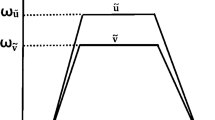Abstract
Neutrosophic trapezoidal fuzzy multi-numbers(NTFMN) are a particular case of neutrosophic fuzzy numbers on a real number set, which are used to predict the solution for multi-criteria decision making problems. In this paper we initiate the definition for NTFMN and formulate a multiple criteria decision-making problems in which the alternatives are NTFMN. Expected value is used for ranking neutrosophic trapezoidal fuzzy multi-numbers and for selection of best alternative. Finally, a numerical example is given to justify the practicality and efficiency of the proposed method.
Similar content being viewed by others
Data availability statement
Data sharing is not applicable to this article as no new data were created in this study.
References
Ali M, Son LH, Deli I, Tien N (2017) Bipolar neutrosophic soft sets and applications in decision making. J Intell Fuzzy Syst 33(6):4077–4087
Atanassov KT (1986) Intuitionistic fuzzy sets. Fuzzy Sets Syst 20(1):87–96
Biswas P, Pramanik S, Giri BC (2014) Cosine similarity measure based multi-attribute decision-making with trapezoidal fuzzy neutrosophic numbers. Neutrosophic Sets Syst 8:46–56
Biswas P, Pramanik S, Giri BC (2018) Distance measure based MADM strategy with interval trapezoidal neutrosophic numbers. Neutrosophic Sets Syst 19:40–46
Biswas P, Pramanik S, Giri BC (2018) Multi-attribute group decision making based on expected value of neutrosophic trapezoidal numbers New Trends in Neutrosophic Theory and Applications. European Union, Brussels, pp 103–124
Biswas P, Pramanik S, Giri BC (2018) TOPSIS strategy for multiattribute decision making with trapezoidal neutrosophic numbers. Neutrosophic Sets Syst 20(1):29–39
Cuong B C and Kreinovich V (2013) Picture fuzzy sets a new concept for computational intelligence problems. In: Proceedings of the Third World Congress on Information and Communication Technologies, Vietnam pp 1–6
Deli I, Ali M, and Smarandache F (2015). Bipolar neutrosophic sets and their application based on multi-criteria decision making problems. In: Proceedings of International Conference on Advanced Mechatronic Systems, China, pp249–254
Deli I, Broumi S, Smarandache F (2015) On neutrosophic refined sets and their applications in medical diagnosis. J New Theory 6:88–98
Dey PP, Pramanik S, and Gir BC (2016) TOPSIS for solving multi-attribute decision making problems under bi-polar neutrosophic environment. New Trends in Neutrosophic Theory and Applications, Brussels, Belgium: European Union, ch. 5, pp 65 - 77
Grzegrorzewski P (2003). The hamming distance between intuitionistic fuzzy sets. In: Proceedings of the 10th IFSA world congress, Istanbul, Turkey, 30, 35–38
Jana C, Pal M, Karaaslan F and Wang J (2018) Trapezoidal neutrosophic aggregation operators and its application in multiple attribute decision making process. Sci Iran, 1–23
Pramanik S, Mallick R (2019) TODIM strategy for multi-attribute group decision making in trapezoidal neutrosophic number environment. Complex Intell Syst 5(4):379–389
Pramanik S, Dalapati S, Alam S, Roy TK (2018) VIKOR based MAGDM strategy under bipolar neutrosophic set environment. Neutrosophic Sets Syst 19:57–69
Pramanik S, Dey PP, Smarandache F (2018) Correlation coefficient measures of interval bipolar neutrosophic sets for solving multi-attribute decision making problems. Neutrosophic Sets Syst 19:70–79
Sebastian S, Ramakrishnan TV (2010) Multi-fuzzy sets. Int Math Forum 5(50):2471–2476
Shinoj TK, John SJ (2012) Intuitionistic fuzzy multisets and its application in medical diagnosis. World Acad Sci, Eng Technol 6(1):1418–1421
Shinoj TK, John SJ (2013) Intuitionistic fuzzy multisets. Int J Innov Sci Eng Technol 2(6):1–24
Smarandache RF (1999) A unifying field in logics neutrosophy neutrosophic probability, set and logic. American Research Press, Rehoboth, pp 7–8
Tan RP, Zhang WD, Broumi S (2019) Solving methods of the shortest path problem based on the trapezoidal fuzzy neutrosophic numbers. Control Decis 34(4):851–860
Tian ZP, Wang J, Zhang HY, Chen XH, Wang JQ (2016) Simplified neutrosophic linguistic normalized weighted bonferroni mean operator and its application to multi-criteria decision-making problems. Filomat 30(12):3339–3360
Uluçay V, Deli I, Sahin M (2016) Trapezoidal fuzzy multi-number and its application to multi-criteria decision-making problems. Neural Comput Appl. https://doi.org/10.1007/s00521-016-2760-3
Wang H, Smarandache F, Zhang YQ, Sunderraman R (2012) Single valued neutrosophic sets. Tech Sci Appl Math 10:10–14
Wang JQ, Li XE (2015) TODIM method with multi-valued neutrosophic sets. Control Decis 30:1139–1142
Yager RR (1986) On the theory of bags. Int J Gen Syst 13:23–37
Yang W, Pang Y (2018) New multiple attribute decision making method based on DEMATEL and TOPSIS for multi valued interval neutrosophic sets. Symmetry 10(4):115
Ye J (2015) Trapezoidal neutrosophic set and its application to multiple attribute decision-making. Neural Comput Appl 26(5):1157–1166
Ye J A(2014). Multicriteria decision-making method using aggregation operators for simplified neutrosophic sets. Journal of Intelligent & Fuzzy Systems , 26(5), 2459 -2466.
Zadeh LA (1965) Fuzzy sets. Inf Control 8(3):338–353
Funding
Not applicable.
Author information
Authors and Affiliations
Contributions
SM: data curation, investigation, resources, writing—original draft. APK: writing—review & editing.
Corresponding author
Ethics declarations
Conflict of interest
The authors declare no competing interests.
Additional information
Publisher's Note
Springer Nature remains neutral with regard to jurisdictional claims in published maps and institutional affiliations.
Rights and permissions
Springer Nature or its licensor (e.g. a society or other partner) holds exclusive rights to this article under a publishing agreement with the author(s) or other rightsholder(s); author self-archiving of the accepted manuscript version of this article is solely governed by the terms of such publishing agreement and applicable law.
About this article
Cite this article
Arun Prakash, K., Suresh, M. Multi-criteria decision making in linguistic values of neutrosophic trapezoidal fuzzy multi-numbers. Evol. Intel. 17, 349–360 (2024). https://doi.org/10.1007/s12065-023-00814-6
Received:
Revised:
Accepted:
Published:
Issue Date:
DOI: https://doi.org/10.1007/s12065-023-00814-6




